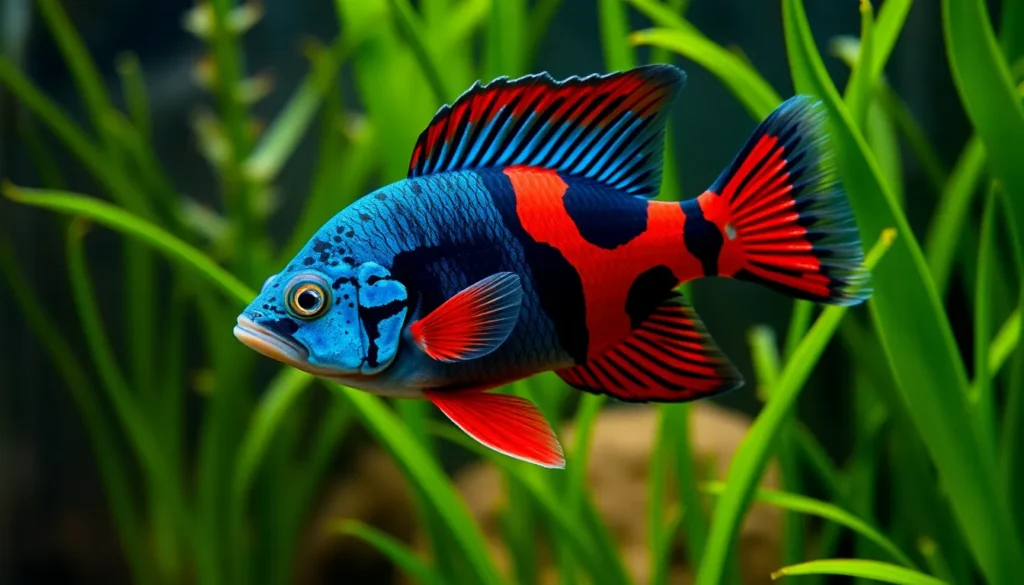Meet the harlequin zeebo, the quirky little creature that’s taken the aquatic world by storm. With its vibrant colors and playful personality, this fish isn’t just another pretty face in the tank; it’s the life of the party. Imagine hosting a fishy soirée, and the harlequin zeebo steals the show with its dazzling dance moves and charming antics. Who knew fish could have such charisma?
Table of Contents
ToggleOverview of Harlequin Zeebo
Harlequin zeebos thrive in freshwater environments, showcasing their stunning colors primarily in Southeast Asian rivers and streams. This vibrant species features a striking mix of blue and red, adorned with black patterns that make it visually appealing to aquarium enthusiasts. Their playful nature sets them apart; these fish participate energetically in schooling behavior and enjoy interacting with others.
Captivity proves beneficial for harlequin zeebos, as they adapt well to community tanks with peaceful species. They prefer planted environments, which mimic their natural habitat. The ideal temperature for harlequin zeebos ranges between 72°F and 79°F, with a pH between 6.0 and 7.5.
Diet plays a crucial role in their health. A balanced diet of high-quality flakes, pellets, and occasional live or frozen foods supports their vibrant colors and active lifestyle. Providing a varied diet prevents nutritional deficiencies.
Breeding these fish can occur in controlled aquariums under appropriate conditions. Selecting healthy adults promotes successful spawning. After laying eggs, separating the adults from the fry ensures a higher survival rate.
Understanding harlequin zeebos enhances the experience of keeping them in home aquariums. Their charming behavior and bright colors contribute to a lively aquatic display, captivating both beginners and experienced fish keepers.
Physical Characteristics

Harlequin zeebos boast vibrant and striking physical traits that contribute to their popularity in aquariums. Their dazzling appearance and unique features make them stand out among freshwater fish.
Coloration and Patterns
Harlequin zeebos exhibit a vivid blend of blue and red, highlighted by bold black patterns. Bright scales shimmer under aquarium lights, creating a captivating visual display. Each fish showcases a distinctive pattern, adding to its individuality. This coloration not only enhances their appeal but also serves as a visual cue within schools. In natural habitats, such vivid colors may play a role in mate selection and social interactions.
Size and Shape
Harlequin zeebos typically reach a length of about 2 to 3 inches. Their elongated bodies feature a streamlined shape, allowing for agile movement in the water. Small fins accentuate their body structure, contributing to overall gracefulness while swimming. Streamlined forms support their energetic behavior, enabling swift darting through aquatic plants. These physical attributes not only enhance their beauty but also facilitate a lively and engaging presence in a community tank.
Habitat and Range
Harlequin zeebos thrive in freshwater environments native to Southeast Asian rivers and streams. Southeast Asia features rich biodiversity, making it an ideal habitat for these vibrant fish. They prefer densely planted areas, where they can dart and hide among aquatic vegetation.
In their natural habitat, harlequin zeebos inhabit slow-moving waters, often in small groups. These fish show a strong affinity for areas with ample cover, such as submerged roots and leafy plants. Streams and rivers provide the necessary conditions for their energetic schooling behavior, allowing for social interaction.
Typically, the range of harlequin zeebos extends through various countries in Southeast Asia, including Thailand, Malaysia, and Indonesia. Various ecosystems within this region support their population, from shallow ponds to larger river systems. Harlequin zeebos enjoy temperatures ranging from 72°F to 79°F and thrive in waters with a pH of 6.0 to 7.5.
Observing their behavior in these natural settings reveals their playful characteristics. They often exhibit schooling and foraging together, further emphasizing their social nature. Captive environments that replicate these conditions enable them to thrive, allowing aquarists to create ideal habitats that closely resemble their native range.
Creating a community tank that mirrors the harlequin zeebo’s natural habitat ensures their health and vibrancy. These conditions promote their lively demeanor and enhance their striking visual display. Ensuring proper tank conditions replicates their preferred environment, supporting the overall well-being of the fish.
Behavior and Social Structure
Harlequin zeebos exhibit vibrant social interactions in their natural and captive environments. Their lively nature emphasizes their preference for schools, which offer both companionship and safety.
Feeding Habits
Harlequin zeebos require a diverse diet to maintain their health and vibrant colors. High-quality flakes serve as a staple, while pellets can enhance nutritional intake. Occasionally including live or frozen foods, such as brine shrimp or daphnia, supports their active lifestyle. This varied diet mimics their natural feeding habits, ensuring they receive essential nutrients. A balanced approach to feeding promotes their overall well-being and striking visual appeal.
Breeding Practices
Breeding harlequin zeebos involves careful preparation and attention. Selecting healthy adults creates optimal conditions for spawning. Once paired, separating them from the fry after egg-laying ensures fry safety and increases survival rates. Providing a separate breeding tank with soft plants fosters a secure environment for egg laying. Observing these practices contributes to successful breeding experiences and vibrant fry development.
Care and Maintenance in Captivity
Harlequin zeebos require specific care and maintenance to thrive in captivity. Understanding their needs ensures a healthy and vibrant aquarium environment.
Tank Requirements
A minimum tank size of 20 gallons maintains optimal water quality for harlequin zeebos. They thrive in densely planted tanks, which offer cover and mimic their natural habitat. Filtration systems should provide gentle water flow, suitable for their preferred slow-moving waters. Temperature settings between 72°F and 79°F support their well-being. Consistent monitoring of pH levels, ideally between 6.0 and 7.5, is essential for their health. Additionally, using high-quality substrate helps facilitate plant growth and enhances overall tank aesthetics.
Diet and Nutrition
Harlequin zeebos flourish on a varied diet that includes high-quality flakes and pellets. Supplementing their meals with live or frozen food, like brine shrimp or daphnia, boosts their colors and enhances vitality. A consistent feeding schedule, offering small amounts multiple times daily, promotes better digestion and health. Adjusting their diet seasonally can help replicate natural feeding patterns. Ensuring a balance in their nutrition assists with growth and activity levels, showcasing their playful nature in the aquarium.
The harlequin zeebo stands out as a vibrant addition to any aquarium. Its lively personality and striking colors not only enhance the beauty of a tank but also create an engaging environment for fish enthusiasts. By understanding their care requirements and social behaviors, aquarists can create a thriving habitat that mirrors their natural surroundings.
With proper attention to their needs, these charming fish can flourish and bring joy to both beginners and seasoned keepers alike. The harlequin zeebo truly embodies the spirit of community and playfulness in the aquatic world.





